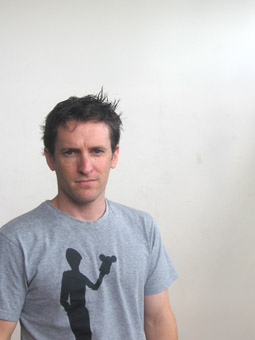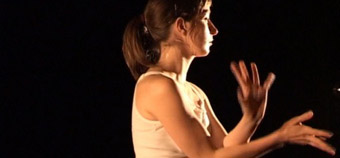opening up the house
sophie travers talks to dancehouse’s david tyndall

David Tyndall
THERE IS CHANGE AFOOT AT DANCEHOUSE IN MELBOURNE, AS THE SMART NEW MICRO-SITE WHICH ACCOMPANIES THE 2008 WEBSITE SUGGESTS. NOT ONLY IS THE LANGUAGE AND IMAGERY CLEARER, SHARPER AND ALTOGETHER MORE DYNAMIC, BUT THE CLUSTERING OF INITIATIVES FOR OPEN APPLICATION IN 2008 SUGGESTS AN ENERGY WHICH ARTISTIC DIRECTOR DAVID TYNDALL IS KEEN TO COMMUNICATE.
Tyndall updated the website himself, admitting that, “As soon as I was in the door, I wanted to address the way Dancehouse is seen by the community and how we see ourselves.” Tyndall is satisfied that his 2008 programme portrays the kind of forward-thinking he has promoted in his first year in the position.
“There has been a lot to do”, he says. “Dianne (Reid, the previous artistic director) left in August 2006 and I did not start till January ‘07, so although her excellent initiatives continued with the help of David Corbet, we had been kind of rudderless for a while. The Board had been working hard to address issues of management and artistic direction, so that by the time I arrived, as the first ever full-time artistic director, they were ready for me to take the reins.”
Tyndall is a VCA graduate and former dancer with recent producer experience with Chunky Move, Dance Works and Expressions dance companies. He has taken to the role of artistic director with relish, delivering a busy program in 2007 and collaborating with his board to instigate organisational change. Tyndall has just advertised for two additional part-time positions, Programme Producer and Venue and Production Co-ordinator, and is excited about how this will free him for further strategic planning.
Dancehouse is triennially funded by both the Australia Council and Arts Victoria, yet its cash turnover of $320-$350K seems small in relation to the volume of activity crammed into the busy program at its North Carlton home. “A huge amount of what happens here is generated by the community”, says Tyndall, “Our members bring their own projects and momentum to the program. There is a challenge to balancing the content we generate and that created by the community. We have to ensure that we are still accessible to the dance community. We do that by remaining affordable and available to hire. In the past couple of years, Dancehouse has been stretched to breaking point with a mass of activity and constant communication. There was a danger that people felt overwhelmed by all this undifferentiated activity and switched off. The board encouraged me to streamline the activity. I have done this by identifying three core areas: research, training and performance. Of course there is a great deal of crossover between those areas and we encourage that. This just helps us to create balance and leave gaps for the community to input.”
Tyndall is enjoying the positive response to his 2008 program. The residency and chance to curate are the most popular additions. “The strongest point of difference from previous years is the focus given to the individual artist through the residency initiative. There has been a tendency to distribute Dancehouse funds across as many artists as possible. This project dedicates $10,500 and 14 weeks of time to a single artist per residency. We needed to connect the many strands of Dancehouse’s activities and in particular to create more meaning around the performance program. So, two artists per year will be supported to make and show work at Dancehouse, to interface with the teaching and research aspects of the program and benefit from the totality of the Dancehouse offer.”
Due to the pressures on his time in 2007, Tyndall was obliged to launch the residency project with a pre-selected artist in order to buy time to perfect the transparency of the selection process. Phoebe Robinson is the first “Housemate” resident for 2008. Tyndall approached a handful of artists involved in the 2007 program and from there selected Robinson. “Phoebe created one of the most popular short works in the Short Shorts performance season in 2007. She’s an artist who would stand to benefit greatly from the residency due to the stage of career she’s at.”

Phoebe Robinson
photo David Tyndall
Phoebe Robinson
Whilst the residency project is the best resourced of Tyndall’s initiatives, he admits it has a way to go. “The residency is open nationally but we are limited to the $10,500. I would eventually like to be able to support all travel and accommodation costs for interstate artists and for the residency to eventually become international.” With the shift of focus of Canberra’s Choreographic Centre to youth dance, Dancehouse has the potential to fill a national gap in the provision of research opportunities for independent artists and Tyndall is developing his dialogue with sister organisations Critical Path in Sydney and Strut in Perth.
In 2008, his Get Out of The House project continues another year of partnership with Strut and Dancebox in Osaka. Two artists will be awarded $5,000 to present their work at these venues. With Critical Path and Strut Tyndall is also sharing the hosting of the Irish choreographers of the Daghdha Dance Company.
Creating the 2008 program, Tyndall considered initiatives to involve the breadth of the independent dance community in Melbourne, from recent graduates to mature artists. The diverse workshop and class program remains, as does the popular mentoring scheme, Learning Curve. There is a Rotary Youth dance project. There are Space Grants and presentation opportunities for work-in-progress or in a fully produced theatrical setting. Your Collection is a new initiative which invites an artist to be employed by Dancehouse as curator of their own season of up to eight works of 10 minute duration, opening out another aspect of the program to community input.
David Tyndall’s definition of the Dancehouse mission sums up the positive energy taking one of Melbourne’s performing arts institutions into an inspiring new year. “Dancehouse is a dynamic and thriving centre for cultural and creative diversity, critical thinking, networking and exchange. Dancehouse seeks to reflect the cultural, economic and political diversity of our community and is an accessible resource for anyone wishing to explore dance as an artist or observer.”
RealTime issue #83 Feb-March 2008 pg. 42






